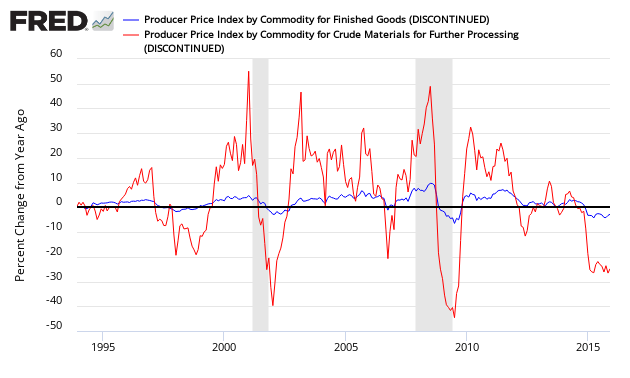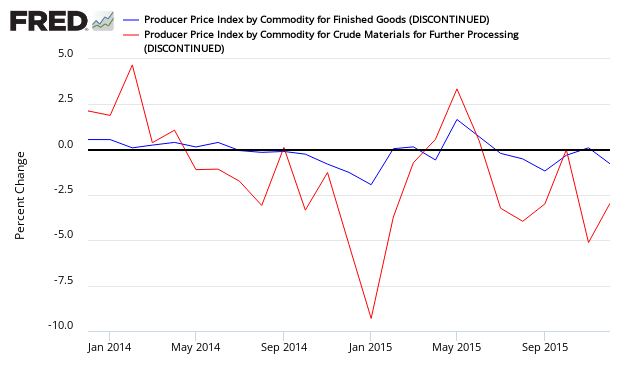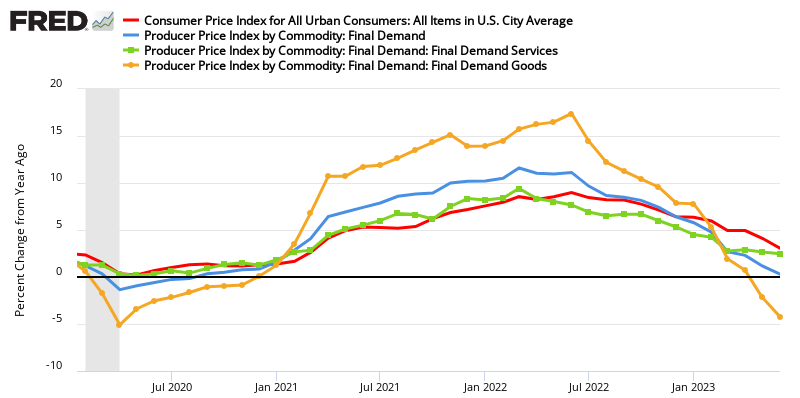April 2014 Producer Prices Index Jumps, Above Expectations
The Producer Price Index inflation jumped again this month following last month's significant increase - with most of the increase coming from food and services.
The PPI represents inflation pressure (or lack thereof) that migrates into consumer price.
- The BLS reported that the Producer Price Index (PPI) finished goods prices (now called final demand prices) year-over-year inflation rate rose from 1.4% to 2.1%.
- The market had been expecting finished goods price inflation of 0.0% to 0.4% (consensus 0.2%) month-over-month versus the +0.6% reported.
- It was the growth in prices for food and costs for the service sector which caused this month’s inflation.
The producer price inflation breakdown:
| category | month-over-month change | year-over-year change |
| final demand goods | 0.6% | |
| final demand services | +0.6% | |
| total final demand | +0.5% | +2.1% |
| processed goods for intermediate demand | 0.0% | +1.5% |
| unprocessed goods for intermediate demand | +0.4% | +6.5% |
| services for intermediate demand | +0.1% | +1.2% |
In the following graph, one can see the relationship between the year-over-year change in crude good index and the finish goods index. When the crude goods growth falls under finish goods – it usually drags finished goods lower.
Percent Change Year-over-Year – Comparing PPI Finished Goods (blue line) to PPI Crude Materials (red line)

Percent Change Month-over-Month- Comparing PPI Finished Goods (blue line) to PPI Crude Materials (red line)

The core PPI (excluding food and energy) was up 0.1% month-over-month (the market expect core to grow 0.0% to 0.3% – consensus 0.2%). Removing food and energy was originally done to remove the noise from the index, however the usefulness in the twenty-first century is questionable except in certain specific circumstance.
PPI Core Inflation (finished goods less food & energy) – Year-over-Year (blue line, left axis) and Month-over-Month (red line, right axis)

Econintersect has shown how pricing change moves from the PPI to the Consumer Price Index (CPI). This YoY change implies that the CPI, should come in around 2.0% YoY.
Comparing Year-over-Year Change Between the PPI Finished Goods Index (blue line) and the CPI-U (red line)

The price moderation of the PPI began in September 2011 when the year-over-year inflation was 7.0%.
Caveats on the Use of Producer Price Index
Econintersect has performed several tests on this series and finds it fairly representative of price changes (inflation). However, the headline rate is an average – and for an individual good or commodity, this series provides many sub-indices for specific application.
A very good primer on the Producer Price Index nuances can be found here.
Because of the nuances in determining the month-over-month index values, the year-over-year or annual change in the PPI index is preferred for comparisons.
There is moderate correlation between crude goods and finished goods as shown on the first graph in this post. Higher crude material prices push the finished goods prices up.
None.





